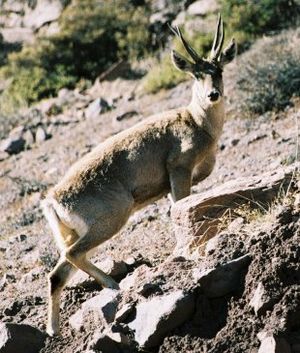Asana, Peru facts for kids
Asana is an important archaeological site in southern Peru. It's located near the Asana River, which flows into the Osmore River, high up in the Andes mountains. This ancient place is about 3,430 meters (11,253 feet) above sea level. People lived here for a very long time, over 8,000 years! At first, they were foragers, meaning they moved around to find food. But later, they started building homes and staying in one place.

Where is Asana?
The Asana site is found on the north side of the Asana River. It sits in a flat, fertile valley that stretches for about 11,270 feet (3,435 meters) along the river. The special way the land and rocks are formed here makes it a unique place.
Asana's History
Archaeologists studied the Asana river valley between 1986 and 1989. They explored about 20 kilometers (12 miles) of the river. This research led to finding the Asana site and six rock shelters. One of these shelters, called Qusquri (or Coscori), was found on the left bank of the river at about 3,000 meters (9,842 feet) high.
People first lived at Asana around 10,500 years ago. Digging at the site showed six different layers of history. These layers cover the time from 10,500 years ago until 3,500 years ago, when the site was left empty. The earliest period, from 10,500 to 9,000 years ago, was during the end of the Late Pleistocene Ice Age. This was 800 years before people settled permanently in other parts of the southern Andes.
During these early times, wild animals like the guanaco and taruca (also called Andean deer) lived there. The first people at Asana were hunter-gatherers. They used the lower parts of the valley as their main camp to hunt these animals. Over many centuries, the guanaco started to be domesticated, meaning people began to tame them.
By about 5,000 years ago, people started to live more permanently at Asana. Between 4,800 and 4,400 years ago, they slowly changed from hunting and gathering to raising animals. By the Middle Holocene age, guanacos were fully domesticated. People who raised animals in the mountains preferred to keep their herds close. They usually stayed within 2 to 4 kilometers (1 to 2.5 miles) of their homes. If they had to travel further or higher, they would set up new camps. For some reason, people suddenly stopped living at Asana.
What Was Found at Asana?
Tools and other stone objects found at Asana show that people moved their camps around. These finds also suggest that different settlements, both high up and lower down, were connected. Archaeologists found both homes and other types of buildings. These structures show that the community grew and changed over time. The buildings found were used between 5,500 and 3,600 years ago.
During digs in 1989 and 1990, a special ceremonial building was discovered. This building was used for ceremonies for about 250 to 500 years. It's the earliest known structure linked to the Kotosh Religious Tradition. Another interesting find was a "dance ground," which is about 4,800 years old. Experts think this area was used for big gatherings and social events.
See also
 In Spanish: Asana (Perú) para niños
In Spanish: Asana (Perú) para niños


